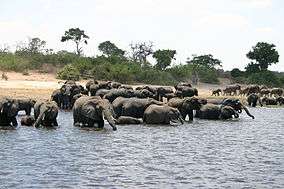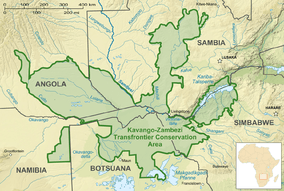Kavango–Zambezi Transfrontier Conservation Area
| Kavango–Zambezi Transfrontier Conservation Area | |
|---|---|
 | |
 | |
| Location | |
| Coordinates | 18°00′S 23°00′E / 18.00°S 23.00°ECoordinates: 18°00′S 23°00′E / 18.00°S 23.00°E |
| Area | 519,912 km2 (200,739 sq mi) |
| Established | 2011 |
| Website |
www |
Kavango–Zambezi Transfrontier Conservation Area (KAZA) is situated in a region of Southern Africa where the international borders of five countries converge. It includes a major part of the Upper Zambezi River and Okavango basins and Delta, the Caprivi Strip of Namibia, the southeastern part of Angola, southwestern Zambia, the northern wildlands of Botswana and western Zimbabwe. The centre of this area is at the confluence of the Zambezi Chobe Rivers where the borders of Botswana, Namibia, Zambia and Zimbabwe meet. It incorporates Chobe National Park, Hwange National Park, and the Victoria Falls.
History
The initiative was created in cooperation with Peace Parks Foundation and the World Wide Fund for Nature. It developed from the Okavango–Upper Zambezi International Tourism Initiative (OUZIT) and the “Four Corners” Transboundary Natural Resource Management. On 24 July 2003, the Ministers responsible for tourism in Angola, Botswana, Namibia, Zambia and Zimbabwe met in Katima Mulilo, Namibia and agreed the vision for the KAZA TFCA initiative.[1] In July 2006 SADC's endorsed the KAZA TFCA as a SADC project, and on 7 December 2006 the Ministers of Environment and Tourism of the five partner countries signed a Memorandum of Understanding at Victoria Falls, Zimbabwe, providing for work towards the establishment of the KAZA TFCA.[1]
In November 2014, the governments of Zambia and Zimbabwe introduced a common KAZA Visa. Angola, Botswana and Namibia are expected to join the scheme.[2]
Components
The Kavango–Zambezi Transfrontier Conservation Area comprises the following protected areas:
in Zambia:
in Namibia:
in Botswana:
- Chobe National Park
- Makgadikgadi National Park
- Nxai Pan National Park
- Moremi Game Reserve
in Zimbabwe:
in Angola:
Several Wildlife Management and Hunting Blocks are also included.
Wildlife
See also
References
- 1 2 "Kavango Zambezi Park Development". Peace Parks Foundation. Retrieved 2010-09-07.
- ↑ "KAZA Visa for Zambia and Zimbabwe". Retrieved 2017-07-12.
- ↑ Elliot, N.B., Cushman, S.A., Macdonald, D.W. and Loveridge, A.J. (2014). "The devil is in the dispersers: predictions of landscape connectivity change with demography". Journal of Applied Ecology. 51 (5): 1169–1178.